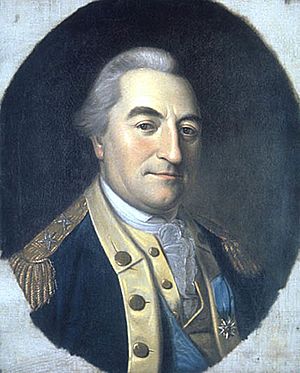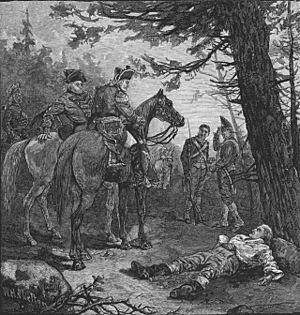Johann de Kalb facts for kids
Quick facts for kids
Johann de Kalb
|
|
|---|---|
 |
|
| Born | June 19, 1721 Erlangen, Brandenburg-Bayreuth, Holy Roman Empire (now Erlangen, Germany) |
| Died | August 19, 1780 (aged 59) Camden, South Carolina, U.S. |
| Buried |
Bethesda Presbyterian Churchyard
Camden, South Carolina, U.S. |
| Allegiance | Kingdom of France United States of America |
| Service/ |
French Army Continental Army |
| Years of service | 1743-1764 1777–1780 |
| Rank | Major-general |
| Battles/wars | War of Austrian Succession Seven Years' War American Revolutionary War |
| Spouse(s) | Anna Elizabeth Emilie van Robais |
| Signature | |
Johann von Robais, Baron de Kalb (born June 19, 1721 – died August 19, 1780) was a military officer from Franconia (a region in Germany). He became a major general in the Continental Army during the American Revolutionary War. He was badly wounded while fighting the British Army at the Battle of Camden and died from his injuries.
Contents
Early Life and Military Start
Kalb was born in Hüttendorf, a German village near Erlangen. His parents were Johann Leonhard Kalb and Margarethe Seitz. He learned French and English. These skills helped him get an important military job in the French Army in 1743. He joined the Loewendal German Regiment.
Military Career and Nobility
Kalb served with great honor in the War of the Austrian Succession. This was a big war in Europe. Later, during the Seven Years' War, he was promoted to lieutenant colonel. This meant he was a high-ranking officer. He also became an assistant quartermaster general. This role involved managing supplies for the army.
In 1763, he received the Order of Military Merit. This was a special award for his brave service. After this, he was given the title of baron. This meant he became a member of the nobility.
In 1764, he left the army. He married Anna Elizabeth Emilie van Robais. She was very wealthy from her family's cloth manufacturing business. They bought a large house in France called the Milon-la-Chapelle chateau. They had three children: Élie, Frederic, and Caroline.
In 1768, Baron de Kalb traveled to America. He was on a secret mission for France. His job was to find out how unhappy the colonists were with British rule. During this trip, he grew to respect the colonists. He admired their strong desire for independence.
Fighting in the American Revolution
In 1777, de Kalb returned to America. He came with his young friend, the Marquis de Lafayette. They both joined the Continental Army. De Kalb was hoping to be made a major general right away. He was upset when he wasn't. But with Lafayette's help, he was given the rank of major general on September 5, 1777.
He spent most of the winter of 1777–78 at Valley Forge. This was a very difficult winter camp for the American army. He commanded a group of soldiers there. He also wrote letters to the French court for John Adams.
De Kalb was sent south to the Carolinas. He was in charge of soldiers from Maryland and Delaware. These troops were sent to help fight the British in the southern states. However, Horatio Gates was chosen to lead the entire army instead of de Kalb. This was a big disappointment for de Kalb.
Gates led the army to a terrible defeat at the Battle of Camden on August 16, 1780. During the battle, de Kalb's horse was shot. He fell to the ground. British soldiers then shot him three times. They also stabbed him many times with their bayonets. His friend, the Chevalier du Buysson, was also badly hurt trying to protect de Kalb.
When Cornwallis, the British general, saw de Kalb, he expressed his sorrow. Cornwallis said he was sad to see de Kalb so badly wounded. He made sure de Kalb's wounds were treated by his own doctors. As de Kalb was dying, he reportedly said he was happy to die as a soldier fighting for freedom. He died three days later and was buried in Camden.
Years later, George Washington visited de Kalb's grave. He reportedly said that de Kalb was a brave stranger. He came from far away to fight for American freedom. Washington wished de Kalb had lived to see America become free.
Legacy and Honors
Baron de Kalb was highly respected by people of his time. Many places in the United States are named after him. These include towns and counties in Alabama, Georgia, Illinois, Indiana, Mississippi, Missouri, New York, Tennessee, and Texas.
There are also streets named after him. These include DeKalb Avenue in Brooklyn, New York City, and DeKalb Pike in Pennsylvania. In Brooklyn, a group called the Knights of Columbus named their council after him in 1906.
His picture was painted after his death by Charles Willson Peale. In 1886, a monument was built to honor Baron de Kalb. It stands on the grounds of the Maryland State House. This monument remembers his important help in the American Revolution.
Two ships in the U.S. Navy were named after him. One was the USS Baron DeKalb, a Civil War ship. The other was the USS DeKalb, a troop transport from World War I.
An American elementary school in Nuremberg, Germany, was also named for him. It was run by the U.S. Department of Defense and closed in the 1990s. Today, the Major General Baron DeKalb Army Reserve Center is at Fort Meade, Maryland. It is the headquarters for the 200th Military Police Command.
Images for kids



